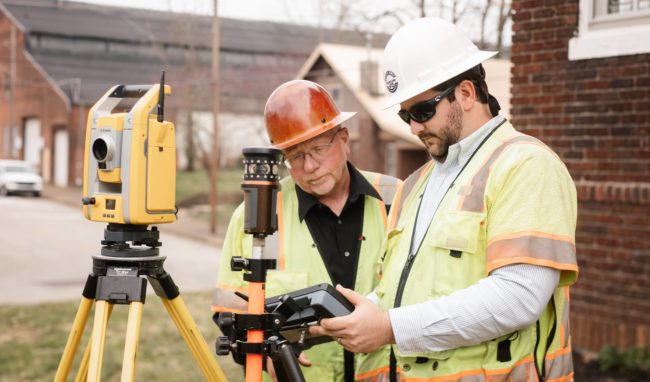
Paris, Tenn.–Celebrated annually during the third week of March, National Surveyors Week brings awareness to the surveying profession and recognizes the contributions of land surveyors and the vital services that they provide to the public. The celebration dates back to 1984, when then-President Ronald Reagan proclaimed it as an industry holiday.
This year, National Surveyors Week will be celebrated on March 19-25, according to the National Society of Professional Surveyors (NSPS). NSPS serves as the voice of surveyors throughout the United States and orchestrates the event each March, with each year focusing on a different theme. This year, the theme is communication, as clear, effective communication is essential in educating the public and our youth about the importance of this profession.
L.I. Smith & Associates in Paris employs a vast surveying staff that includes both field and office personnel. More than 10 field crews, each comprised of a party chief and one or more rodmen, travel throughout 11 states to complete field work. In the office, six licensed surveyors– Patrick Smith, Larry Smith, Chris Conrad, Tommy Young, Mason Peale, and Trevor Teague — work with survey technicians to complete boundary and topographical surveys, route surveys, land title surveys, utility surveys, and constructional layout for public and private entities.
Summer internships are available at LIS at the collegiate and high school levels. Survey Interns work directly under the mentorship of the party chiefs in the field, allowing students to grow their talents in a fast-paced, dynamic environment. Job shadowing is also available for those interested in surveying but aren’t ready to complete an internship.
While sometimes overlooked, land surveying, a profession in which data is collected to create maps and a detailed record of land features, is a viable career that is needed in many industries, including the engineering, construction, forensic, environmental, and hydrography fields, among numerous others. With the average age of a licensed Professional Land Surveyor (PLS) in United States at 57, there could soon be a shortage of surveyors as this age group retires, leaving young people with a large gap in the workforce that will need to be filled.
Vice President Chris Conrad said, “As surveyors, like me, continue to get older, it is essential that we educate the younger generation about this vast profession.”
Individuals pursuing a career in surveying have job opportunities at all levels, with positions available outdoors in a field position or in an office setting. For those who enjoy working with their hands or working outside, positions such as a rodman or party chief may be a good fit. These positions generally provide extensive on the job training, and neither of these roles require a college degree.
Office positions are also available for those choosing not to further their education. Survey technicians work on Computer-Aided Design (CAD) software to draft, design, and layout surveys. Technicians provide support to project managers and survey crews and play a key role in projects. While specialized software experience is necessary for these positions, a degree is not required.
For those seeking a professional path, professional licensure is available. To become a Registered Land Surveyor (RLS), a person should obtain a bachelor’s degree in land surveying or a related field of study. The Fundamentals of Surveying (FS) must be successfully passed at the start of the licensing process. Once requirements are met and the exam is passed, they must submit a Professional Surveyor-In-Training (PLSIT) application to obtain a PLSIT certification. Finally, after completing the minimum number of mentorship hours and any other requirements, the individual will be eligible to sit for the state specific exam and, if successful, can upgrade to full licensure as a Professional Land Surveyor.
“Professional surveyors are problem solvers, historians, and sometimes mediators. The greatest thing about surveying is there is no boredom, as no two days are ever the same,” Conrad said.
Conrad said, “Using the knowledge obtained through science, technology, engineering, and mathematics (STEM) programs, young people already possess the foundation to pursue a career in surveying.”
For more information about career or internship opportunities at LIS, contact Ashley Horn at careers@lismith.com.



